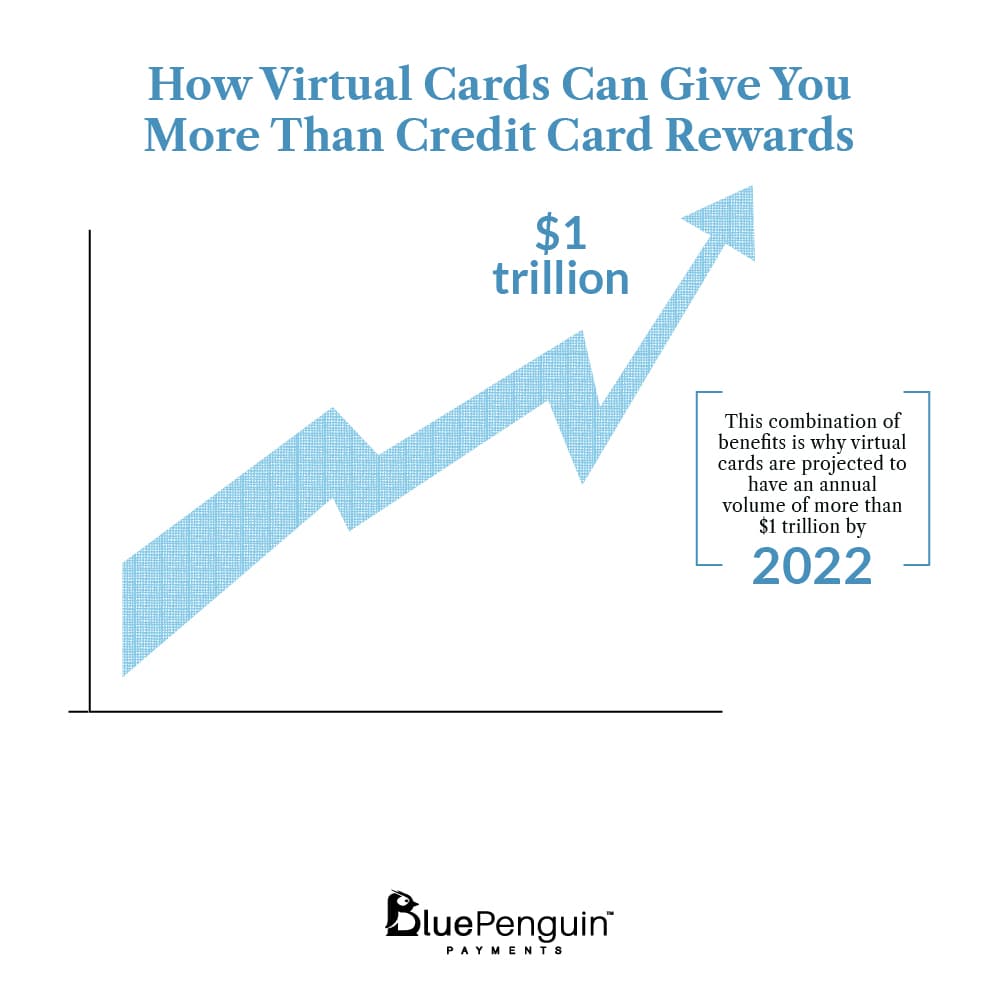08/17/20
Businesses have taken advantage of credit card reward programs for years now. These points, perks, or cashback rewards are an excellent way for companies to get value from payments they have to make.
Today, though, businesses realize there’s a better way to pay — virtual cards. With virtual cards, companies obtain greater control over their finances while simultaneously increasing security and earning even better rewards.
This combination of benefits is why virtual cards are projected to have an annual volume of more than $1 trillion by 2022.

The same report found that the adoption of virtual cards for B2B payments will be slow to catch on. But why? Perhaps business owners may be reluctant to try something new, relying on paper checks or traditional credit cards.
There are many reasons virtual cards can give you more than credit card rewards, though. Here are three.
Virtual cards are unique 16-digit cards issued by a card brand (MasterCard, Visa, or Discover). They are generated by Accounts Payable departments for a specific dollar amount and a specific purchase.
Because of this, businesses have much better control over their spending. Virtual cards can be issued for each invoice payment, and for the exact amount of that invoice. Any attempted payment above or below that amount won’t go through.
Virtual cards also allow businesses to monitor spending in real-time. AP departments don’t have to wade through multiple charges on a credit card to see what’s been issued and what’s cleared. This cuts down on reconciliation significantly.
Virtual card payments can even be integrated directly with your accounting or ERP system. This allows all AP workflow to be managed together in one system. The removal of this data bottleneck makes the entire AP process more efficient.
Even though credit cards have a digital component, they still have spending limits, carry interest charges on any balances carried from month to month, and can affect your corporate credit rating. Virtual cards have none of these restraints or negative impacts.
One of the biggest concerns with any payment is security. Unfortunately, bad actors are constantly trying to hack into systems to steal valuable personal and financial information. Even with the highest encryption technology, credit card numbers can still be stolen and used for fraudulent purchases by social engineering and “spearphishing” attacks, such as what happened at Twitter in July 2020. The issue with using cards is that you’re relying on your vendors to ensure they protect your data properly in both their systems and their manual processes. If they don’t, you could be the victim of debilitating fraud.
In addition, traditional credit cards are linked to other personal information. If your business credit card is compromised, it’s possible other sensitive information will be at risk, too.
Virtual credit cards are the next step in digital payment security. If a hacker gained access to a virtual card number, they’d be sadly disappointed because Virtual cards have no sensitive information attached to them, are only valid for a specific dollar amount (to the penny) and can be limited to a specific vendor or vendor type (MCC.)
Virtual cards can be created as a single-use card that expires and is removed from the network once used by your vendor. Virtual cards can also be created as a reloadable card so that your vendors can store credit card information after purchases are made. They do this to make future payments easier and more convenient for you so you don’t have to send them a new card every time you want to pay an invoice.
No one would have access to your business bank account or other financial accounts, even if they were to obtain the numbers.
Sure, traditional credit cards offer rebates, cash back, and rewards. But these usually come with a limit. Either the business is issued a limit on the total balance of the card, or there’s a limit to how much you can earn in rewards. And if you use your points to make a purchase, the product you get is usually priced above retail price, which makes your points even less valuable.
This doesn’t apply to virtual cards. Most virtual card packages will offer straight cash back on all invoice payments. Assuming a minimum .75% cashback for at least 65% of your invoice payments (BluePenguin’s average vendor acceptance rate), that’s a significant amount of cash flow potential.
As of 2018, U.S. business owners spend $430 billion on credit cards every year. If you run the above assumptions, that’s $2.1 billion in possible rewards!
Traditional payment types like ACH and credit cards might seem like the most logical form of digital payments. But today, they hold companies back more than they help push them forward.
The benefits of virtual cards are undeniable. The control over costs and streamlined nature of AP processes is something credit cards can’t provide. Neither is the added security of one-time accounts for one set invoice amount. And neither is the immense earning potential of limitless cashback.
Making the transition to virtual cards for invoice payments may seem too challenging a task to undertake. But BluePenguin can help. We help companies transition invoice payments to virtual cards as part of a fully integrated ePayables strategy. Contact us to learn how you can take the next step in AP automation.
Back to News and Articles